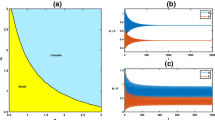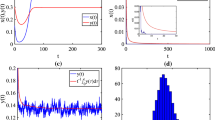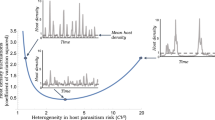Abstract
Spatial synchrony is common, and its influences and causes have attracted the interest of ecologists. Spatially correlated environmental noise, dispersal, and trophic interactions have been considered as the causes of spatial synchrony. In this study, we developed a spatially structured population model, which is described by coupled-map lattices. Our recent investigation showed that trophic correlation of environmental noise was another important factor that affects spatial synchrony. As a supplement, we considered the influence of the color of the environmental noise on the spatial synchrony in this study. The noise color refers to the temporal correlation in the time series data of the noise, and is expressed as the degree of (first-order) autocorrelation for autoregressive noise. Patterns of spatial synchrony were considered for stable, periodic (quasi-periodic), and chaotic population dynamics. Numerical simulations verified that the color of the environmental noise is another mechanism that causes spatial synchrony. Generally, the effect of the color of the noise on the synchrony is dependent on the type of dynamics (stable, cyclic, chaotic) present in the population. For cyclic dynamics, simulation results clearly demonstrate that reddened noise has higher synchrony than white noise. The importance of our research is that it enriches the theory of potential causes of spatial synchrony.





Similar content being viewed by others
References
Bascompte J, Solé RV (eds) (1998) Modeling spatiotemporal dynamics in ecology. Springer, Berlin
Bjørnstad ON (2000) Cycles and synchrony: two historical “experiments" and one experience. J Anim Ecol 69:869–873
Bjørnstad ON, Bascompte J (2001) Synchrony and second order spatial correlation in host–parasitoid systems. J Anim Ecol 70:924–933
Bjørnstad ON, Ims RA, Lambin X (1999) Spatial population dynamics: analyzing patterns and processes of population synchrony. Trends Ecol Evol 14:427–432
Blasius B, Huppert A, Stone L (1999) Complex dynamics and phase synchronization in spatially extended ecological systems. Nature 399:354–59
Bolker BM, Grenfell BT (1996) Impact of vaccination on spatial correlation and persistence of measles dynamics. Proc Natl Acad Sci USA 93:12648–12653
Briggs C, Hoopes MF (2004) Stabilizing effects in spatial parasitoid–host and predator-prey models: a review. Theor Popul Biol 65:299–315
Cazelles B, Boudjema G (2001) The Moran effect and phase synchronization in complex spatial community dynamics. Am Nat 157:670–675
Cazelles B, Stone L (2003) Detection of imperfect population synchrony in an uncertain world. J Anim Ecol 72:953–968
Cazelles B, Bottani S, Stone L (2001) Unexpected coherence and conservation. Proc R Soc Lond B 268:2595–2602
Cazelles B, Chavez M, Constantin de Magny G, Guégan JF, Hales S (2007) Time dependent spectral analysis of epidemiological time series with wavelets. J Royal Soc Interface 4:625–636
Earn DJD, Levin SA, Rohani P (2000) Coherence and conservation. Science 290:1360–1364
Fontaine C, Gonzalez A (2005) Population synchrony induced by resource fluctuations and dispersal in an aquatic microcosm. Ecology 86:1463–1471
Gao M, Li W, Li Z, Dai H, Liu H (2007) Spatial synchrony in host-parasitoid populations. Ecol Model 204:29–39
Grenfell BT, Wilson K, Finkenstädt BF, Clutton Brock TH, Crawley MJ (1998) Noise and determinism in synchronized sheep dynamics. Nature 394:674–677
Gyllenberg M, Söderbacka G, Ericsson S (1993) Does migration stabilize local population dynamics? Analysis of a discrete metapopulation model. Math Biosci 118:25–49
Halley JM, Kunin VE (1999) Extinction risk and the family of noise models. Theor Popul Biol 56:215–230
Haydon D, Steen H (1997) The effects of large-and small-scale random events on the synchrony of metapopulation dynamics: a theoretical analysis. Proc R Soc Lond B 264:1375–1381
Heino M (1998) Noise colour, synchrony, and extinctions in spatially structured populations. Oikos 83:368–375
Henio M, Kaitala V, Ranta E, Lindström J (1997) Synchronous dynamics and rates of extinction in spatially structured populations. Proc R Soc Lond B 264:481–486
Heino M, Ripa J, Kaitala V (2000) Extinction risk under colored environmental noise. Ecography 23:177–184
Holmes EE, Lewis MA, Banks JE, Vet RR (1994) Partial differential equations in ecology: spatial interactions and population dynamics. Ecology 75:17–29
Ims RA, Steen H (1990) Geographical synchrony in microtine population cycles: a theoretical evaluation of the role of nomadic avian predators. Oikos 57:381–387
Jansen VA (1999) Phase locking: another causes of synchrony in predator–prey systems. Trends Ecol Evol 14:278–279
Kendall J, BE, Bjørnstad ON, Bascompte J, Keitt TH, Fagan WF (2000) Dispersal, environmental correlation and spatial synchrony in population dynamics. Am Nat 155:628–635
Koenig WD (1999) Spatial autocorrelation of ecological phenomena. Trends Ecol Evol 14:22–26
Laakso J, Kaitala V, Ranta E (2001) How does environmental variation translate into biological process? Oikos 92:119–112
Li Z, Gao M, Hui C, Han X, Shi H (2005) Impact of predator pursuit and prey evasion on synchrony and spatial patterns in metapopulation. Ecol Model 185:245–254
Liebhold A, Walter D, Koenig WD, Bjørnstad ON (2004) Spatial synchrony in population dynamics. Annu Rev Ecol Evol Syst 35:467–490
Matter SF (2001) Synchrony, extinction, and dynamics of spatially segregated, heterogeneous populations. Ecol Model 141:217–226
Moran PAP (1953) The statistical analysis of the Canadian lynx cycle 2. Synchronization and meteorology. Aust J Zool 1:291–298
Murray JD (1993) Mathematical biology, 2nd corrected edn. Springer, Berlin
Myers RA, Mertz G, Bridson J (1997) Spatial scales of interannual recruitment variation of marine, anadromous, and freshwater fish. Can J Fish Aquat Sci 54:1400–1407
Petchey OL, Gonzalez A, Wilson HB (1997) Effects of population persistence: the interaction between environmental noise colour, intraspecific competition and space. Proc R Soc Lond B 264:1841–1847
Post E, Forchammer MC (2002) Synchronization of animal population dynamics by large-scale climate. Nature 420:168–171
Ranta E, Kaitala V, Lindström L (1995) Synchrony in population dynamics. Proc R Soc Lond B 262:113–118
Ranta E, Lundberg P, Kaitala V, Laakso J (2000) Visibility of the environmental noise modulating population dynamics. Proc R Soc Lond B 267:1851–1856
Ripa J, Lundberg P (1996) Noise color and the risk of population extinction. Proc R Soc Lond Ser B 263:1751–1753
Ripa J, Heino M (1999) Linear analysis solves two puzzles in population dynamics: the route to extinction and extinction in colored environments. Ecol Lett 2:219–222
Ruokolainen L, Fowler MS, Ranta E (2007) Extinctions in competitive communities forced by colored environmental variation. Oikos 116:439–448
Ruxton GD (1996) Dispersal and chaos in spatially structured models: individual-level approach. J Anim Ecol 65:161–169
Sabo JL (2005) Stochasticity, predator-prey dynamics, and trigger harvest of nonlinear predators. Ecology 86:2329–2343
Schwager M, Johst K, Jeltsch F (2006) Does red noise increase or decrease extinction risk? Single extreme events versus series of unfavorable conditions. Am Nat 167:221–231
Sinclair BJ (2001) Field ecology of freeze tolerance. Interannual variation in cooling rates, freeze-thaw and thermal stress in the microhabitat of the alpine cockroach Celatoblatta quinquemaculata. Oikos 93:286–293
Steele JH (1985) A comparison of terrestrial and marine ecological system. Nature 313:355–358
Sugihara G (1994) Nonlinear forecasting for the classification of natural time series. Phil Trans R Soc Lond A 348:477–495
Wichmann MC, Johst K, Moloney KA, Wissel C, Jeltsch F (2003) Extinction risk in periodically fluctuating environments. Ecol Model 167:221–231
Acknowledgments
This work was supported by the National Natural Science Foundation of China (No. 30470298; 30700100) and the National Social Science Foundation of China (No. 04AJL007). We thank the two anonymous reviewers whose comments were important in improving this article.
Author information
Authors and Affiliations
Corresponding author
Appendix
Appendix
When the model has only local dispersal, our results are the same. We find that spatial synchrony increases with increasing dispersal rate d. Moreover, spatial synchrony also increases with increasing α. Some statistical tests were performed to investigate the effect of the red noise. When d = 0.15, the t-test (P = 2.2 × 10−16) clearly demonstrated that red noise (α = 0.8) has a stronger synchronizing effect than white noise (α = 0).
About this article
Cite this article
Liu, Z., Gao, M., Li, Z. et al. Dispersal, colored environmental noise, and spatial synchrony in population dynamics: analyzing a discrete host–parasitoid population model. Ecol Res 24, 383–392 (2009). https://doi.org/10.1007/s11284-008-0513-1
Received:
Accepted:
Published:
Issue Date:
DOI: https://doi.org/10.1007/s11284-008-0513-1




